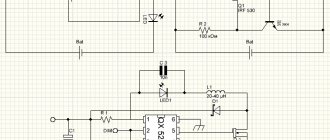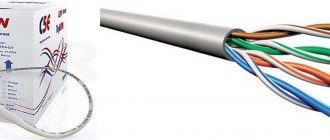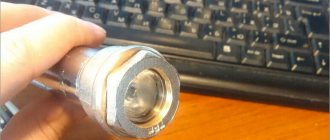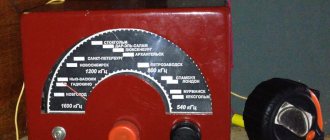The value of a screwdriver as a home or construction tool most often lies in its portability. However, due to certain circumstances, portability sometimes has to be abandoned in favor of functionality. We are talking about converting a cordless screwdriver into a mains-powered tool. This process has a number of subtleties that it is advisable to observe.
Types of battery cells
These devices use elements of different types and voltages, each of which has its own advantages and disadvantages.
The most common are nickel-cadmium (Ni – Cd) with a voltage of 1.2V.
Advantages:
- low price;
- stored in a discharged state.
Flaws:
- have a memory effect;
- high self-discharge;
- small capacity;
- small number of charge/discharge cycles.
More advanced nickel-metal hydride (Ni-MH) voltages are 1.2V.
Advantages:
- less memory effect and self-discharge;
- large capacity and number of charge/discharge cycles.
Flaws:
- higher price;
- do not tolerate low temperatures and storage in a discharged state.
The most advanced lithium-ion (Li-Ion) voltage 3.6V.
Advantages:
- no memory effect;
- very low self-discharge current;
- high specific capacity, allowing to reduce the weight and dimensions of the device;
- the number of charge/discharge cycles is many times higher than other types of batteries.
Flaws:
- high price;
- loss of capacity three years after manufacture.
Should I charge it before long-term storage?
Haven't used your screwdriver battery for a long time? Experts give the following recommendations.
- Before storage, nickel-cadmium For long-term storage, you need to carry out 3-5 full charging/discharging cycles.
- Nickel-metal hydride batteries have a higher self-discharge rate, unlike previous elements. Experts advise keeping them charged, and after a long break, leaving them to recharge for a day. The capacity decreases after 200-300 charge-discharge cycles. Partial discharge is allowed for this type.
- Lithium-ion batteries are distinguished by the complete absence of the “memory effect”. The battery can be charged whenever you want. It is not recommended to completely discharge them, as this may disable the protective circuit. They are equipped with special controllers that, at high temperatures, turn off the element to prevent overload. You can store the cell charged only 50%.
Read also: Beading on a machine for beginners
Homemade power supply
It is necessary to start making a homemade power supply if you have knowledge in the field of radio engineering. It is necessary to prepare parts and tools in advance and fully concentrate on the work, during which the radio element may fail or suffer electric shock (supply voltage 220 V).
The simplest scheme
During manufacturing, it is necessary to prepare a housing for mounting radio components, a tool, a piece of getinax, wire and radio components. Then proceed with assembly according to diagram 1.
Scheme 1 – Simple 12 or 18 volt power supply.
Almost any transformer with the following parameters is suitable: power 250..300 W, secondary voltage 24..30 V, and current rated from 15 A and above. The diode bridge is assembled from powerful diodes (selected from a reference book). After assembly, it is necessary to check the supply voltage: if it is higher than the required value, then you need to reduce the voltage of winding II (reducing the number of turns). At low voltage, wind the secondary with a wire of the same cross-section. After assembly, install it in the housing.
Provided that the screwdriver is not powerful enough, you can install it directly in the battery compartment. If the power supply is assembled separately, it is recommended to provide cooling, because during engine startup the rated current increases by 7 times. As a result of this increase, a load is placed on the power supply unit, and it begins to heat up. Heating occurs due to insufficient power from the power supply. After the power supply is ready, you need to check the screwdriver: run it several times and make sure that the radio elements do not heat up. When using a converted screwdriver, you must adhere to the basic requirements:
- It is necessary to give the tool time to cool down after every 20..30 minutes of operation.
- Do not work at high heights or do it carefully (the BP may fall and, as a result, loss of balance and injury).
- Monitor the condition of the power cable; it should not be pinched (this can lead to a short circuit, which is fraught with negative consequences for the tool and people).
Thus, if the screwdriver battery outputs 18 V or 12 V, it is not at all necessary to buy a new battery or screwdriver. It all depends on the scope of use of the tool: if you need to move the tool, you should replace the battery or purchase a new screwdriver. In the case where mobility does not play a special role, you need to convert it to power from the network. By following simple recommendations and observing safety regulations, you can not only increase the likelihood of extending the service life, but also reduce the risk of injury.
Schemes and their description
The option of self-assembly of the power supply must be made subject to knowledge in the field of radio engineering. In addition, before assembly you need to think carefully about everything, find a housing for installation and the corresponding radio elements.
A simple power supply option
A simple circuit of 1 power supply (screwdriver from a 220 volt network), consisting of a power transformer (diode bridge input), a rectifier and a capacitor filter.
Scheme 1 - Power supply for 18 V screwdriver
The transformer must be selected with a power of 300 W and above, the voltage on winding II must be in the range from 20 to 24 V and the current strength is over 15 A. For the diode bridge, powerful diodes should be used, selected for the current of the secondary winding. It will be more difficult to select the appropriate power supply for the screwdriver. At the output of the rectifier, it is necessary to install a capacitor with a capacity of 2000 μF (you can limit yourself to a capacity of 470) and a voltage of 25 V and above. Parts must be taken with a reserve of current and voltage. All radio elements are mounted on a getinaks board, which is mounted in the housing.
Universal power adapter
The proposed version of the universal power supply has excellent characteristics and can withstand a load current of up to 10 A. The output voltage is 18 V, although you can make calculations and make a power supply for a 12 V screwdriver. This power supply can be used as a battery charger and backup power source in case of network blackout (Scheme 2).
The adapter is assembled on a voltage stabilizer consisting of transistor VT3 and VD2-VD5 (zener diodes). Using toggle switch SB1, the power is turned on and relay K1 closes its contacts. The power goes to a transformer, which converts alternating current to the required rating. The output current from the transformer goes to the rectifier. Next, the rectified voltage is supplied to the stabilizer. There is also a current amplifier in the circuit, assembled on transistors VT1 and VT2. A load is connected to this amplifier. The battery recharging mode (backup power source) is carried out through VD6 and a limiter in the form of resistor R4. Using SB2 you can disable battery charging.
Screwdriver device
This mechanism consists of the following parts:
- DC motor. It has the shape of a cylinder; instead of an excitation winding, the housing contains permanent magnets. This simplifies the design and provides sufficient torque at low speeds. The drive (sun) gear of the planetary gearbox is mounted on the electric motor shaft;
- Reversible speed controller. The adjustment circuit is assembled on a PWM controller and a field-effect transistor. Reversing is carried out by switching the polarity of the power connection to the motor brushes;
- Planetary reductor. Made in a separate building. It got its name because of its resemblance to the solar system. Consists of a ring gear, a central (sun) gear, satellites and a carrier. The ring gear transmits force through the spring-loaded balls of the load regulator. There are models with two-speed gearboxes. Increased speed is activated when using the device as a drill;
- Rotation force limitation mechanism. Serves to limit the force when tightening screws. Transmits torque through balls pressed by an adjustable spring;
- Removable battery. Consists of individual elements in one housing. The voltage in different models ranges from 9 to 18 volts.
Screwdriver device
Homemade charging devices
It’s quite simple to make a charger for a 12-volt screwdriver yourself, by analogy with the one used in the Interskol charger. To do this, you will need to take advantage of the ability of the thermal relay to break the contact when a certain temperature is reached.
In the circuit, R1 and VD2 represent a sensor for the flow of charge current, R1 is designed to protect the diode VD2. When voltage is applied, transistor VT1 opens, current passes through it and LED LH1 begins to glow. The voltage drops across the chain R1, D1 and is applied to the battery. The charging current passes through the thermal relay. As soon as the temperature of the battery to which the thermal relay is connected exceeds the permissible value, it is triggered. The relay contacts switch and the charging current begins to flow through resistance R4, the LED LH2 lights up, indicating the end of the charge.
Circuit with two transistors
Another simple device can be made using available elements. This circuit operates on two transistors KT829 and KT361.
The amount of charge current is controlled by the KT361 transistor to the collector to which the LED is connected. This transistor also controls the state of the KT829 component. As soon as the battery capacity begins to increase, the charging current decreases and the LED gradually goes out accordingly. Resistance R1 sets the maximum current.
The moment the battery is fully charged is determined by the required voltage on it. The required value is set with a 10 kOhm variable resistor. To check it, you will need to place a voltmeter on the battery connection terminals, without connecting the battery itself. Any rectifier unit designed for a current of at least one ampere is used as a constant voltage source.
Using a custom chip
Manufacturers of screwdrivers are trying to reduce prices for their products, often this is achieved by simplifying the charger circuit. But such actions lead to rapid failure of the battery itself. By using a universal chip designed specifically for the MAXIM MAX713 charger, you can achieve good charging performance. This is what the charger circuit for an 18-volt screwdriver looks like:
The MAX713 chip allows you to charge nickel-cadmium and nickel-metal hydride batteries in fast charge mode, with a current of up to 4 C. It can monitor battery parameters and, if necessary, reduce the current automatically. Once charging is complete, the IC-based circuit draws virtually no power from the battery. It can interrupt its operation due to time or when the temperature sensor is triggered.
HL1 is used to indicate power, and HL2 is used to display fast charge. The setup of the circuit is as follows. To begin with, the charging current is selected, usually its value is equal to 0.5 C, where C is the battery capacity in ampere hours. The PGM1 pin is connected to the positive supply voltage (+U). The power of the output transistor is calculated using the formula P=(Uin - Ubat)*Icharge, where:
- Uin – highest voltage at the input;
- Ubat – battery voltage;
- Icharge – charging current.
Resistance R1 and R6 is calculated using the formulas: R1=(Uin-5)/5, R6=0.25/Icharge. The choice of time after which the charging current turns off is determined by connecting the PGM2 and PGM3 contacts to different terminals. So, for 22 minutes PGM2 is left unconnected, and PGM3 is connected to +U, for 90 minutes PGM3 is switched to the 16th leg of the REF chip. When it is necessary to increase the charging time to 180 minutes, PGM3 is short-circuited with the 12th leg of the MAX713. The longest time of 264 minutes is achieved by connecting PGM2 to the second leg, and PGM3 to the 12th leg of the microcircuit.
Assembly of the working structure
For ease of use and connection, I brought the cord from the power supply into the battery case. I took a 3.5 meter long cord that was available. I removed all the battery cells from the battery and installed an LC filter. Now, if I somehow get a working battery, I can always put it on a screwdriver and put the power supply away as a reserve. I didn’t throw the batteries out of the battery, I have an idea where to use them, but that’s a topic for another review.
Since the cord connecting the unit to the screwdriver has a certain resistance and inductance, you can try to close the terminals of the L1 coil with a jumper. In theory, this could increase power by a tiny amount.
The screwdriver feels great with a cord, but to be honest, it seemed a little weak to me when braking by hand. But trial tightening of the self-tapping screws dispelled my doubts: self-tapping screws 35 mm long can easily be screwed into 20 mm plywood. This means that a screwdriver will cover most repair needs.
I cut off all the output wires from the block, leaving the green starting wire; I soldered its end to the common conductor of the board, where all the black ones are soldered. It's best to carefully desolder all the wires, but my soldering iron was too weak for this and had to be cut. I soldered two short, hard copper wires to the common contact and +12 (where the yellow ones are soldered) and connected them through the terminal block to the cord to the Shura.
This is where we will finish this review; we have achieved what we wanted - the screwdriver works perfectly with a computer power supply. In the future, I plan to make a high-quality plywood case without cracks for the power supply board - tests have shown that the heatsinks on the board do not heat up at all and you don’t have to worry about overheating of the elements in a closed case.
Is a rework necessary?
Should I remake the screwdriver or not? Before starting work, it is necessary to evaluate the advantages and disadvantages of this solution. If we talk about the first, then as a result the owner will achieve:
- disappearance of problems with a suddenly discharged tool;
- lack of dependence on low temperatures, because under such conditions the batteries discharge very quickly;
- obtaining stable torque;
- significant savings, since purchasing a new, rather expensive battery is not required.
In addition, this is the only remaining option if the model has already been discontinued, when the tool is urgently needed, and there is no time to wait for the arrival of a new battery. If the screwdriver itself works flawlessly, then there are no contraindications to modifying it. The only thing he will lose is mobility, but this minus is still not so significant, it can be dealt with.
Easy tool restoration
The main advantage of a cordless screwdriver is its mobility. These tools use a lithium-ion battery, which is protected from overload and complete discharge. In addition, there is protection against overcharging in the form of a separate circuit built into the element itself. The main power source (primary) is 220 V, and the battery is also recharged.
Depending on the model of the screwdriver, the battery receives a charging voltage from 14 V to 21 V. The battery output produces a supply voltage from 12 to 18 V. This type of battery lasts a long time, but if the tool is not used for a long time, the built-in discharge protection will not help battery cells: discharge occurs constantly.
To increase service life, it is necessary to constantly discharge and charge the battery. If for some reason it was not possible to “keep track” of the tool, a specific battery element often fails. There are basic ways to solve this problem:
- Replace the battery with a new one.
- Buy a new tool.
- Convert a mains-powered screwdriver.
When replacing the battery, please note that a new one is quite difficult to find. The tools are made in such a way that it is difficult to find spare parts for them. It is not profitable for a company to produce its product with high repairability, since it needs income from the purchase of products. You can only find a new battery at dealers. In addition, another option is possible: disassemble the battery and replace the faulty battery.
When purchasing a new tool, the user tends to buy a model of a higher quality, forgetting about the rules for using lithium-ion batteries. Basic rules that will help preserve the service life of the tool for a long time:
- When purchasing in winter, it is strictly forbidden to “launch” the tool immediately. You need to wait about an hour until it “warms up” to room temperature.
- Place the battery on charge.
- Perform the battery charging and discharging cycle about 3 times.
If none of the options for solving the problem are suitable, you need to start converting the screwdriver to a network one with your own hands. It's easy to do. There are many simple and complex ways. Changing the tool model has several positive aspects:
- There is no need to recharge the battery.
- The load on the mechanical part is reduced.
- Lots of power supply options.
- Increasing the quality characteristics of the product.
This is interesting: Sanding machine for parquet and floors - we look at it in detail
Features of charging of one type or another + (Video)
The initial charging of the screwdriver is considered a very significant factor, since it determines whether the full charge capacity becomes active or not. Any type of battery has its own characteristics of primary charging. The process of recharging a nickel-cadmium battery is somewhat complicated. Initially, it needs to be recharged three times in a row, and so that the charge capacity remains full.
It is recommended to completely discharge the nickel-metal hydride type for the first time, and also fully charge it. The complete charging/discharging cycle is repeated 4-5 times, then you can safely charge and discharge the battery regardless of how full the container is.
There are no special rules for lithium-ion; the capacity remains unchanged for a long time.
Advice! Do not allow the power supply to overheat above 50 degrees.
Connecting the screwdriver to the charger
Sequencing:
- Solder or attach two wires with alligator clips to the terminals of the charger.
- Disassemble the old battery and remove the dead cells from it.
- Drill a hole in the battery case for the cable, thread the cable into the hole. It is advisable to seal the connection with electrical tape or heat-shrink tubing to prevent the wire from tearing out of the housing.
- Elements removed from the battery will disrupt the weight distribution of the screwdriver - your hand will get tired. To restore balance, a weight should be placed in the body - it can be dense wood or a piece of rubber.
- Solder the cable to the terminals of the former battery, connected to the screwdriver.
- Assemble the battery housing.
- All that remains is to test the updated tool in action.
Installation of a finished power supply in the housing of an old battery
Procedure:
- Disassemble the old battery and remove the non-functioning elements from it.
- Install the power supply into the battery case. Connect the high voltage terminals and low voltage terminals.
- Assemble and close the battery case.
- Install the battery into the screwdriver.
- Plug the power supply into the outlet and check the updated network tool in operation.
Homemade power supply
Step-by-step instruction:
- Disassemble the old battery case and remove the dead batteries from it.
- Install the elements of the electrical circuit of the power supply onto the circuit board, solder the contacts.
- Install the assembled board into the case. Use a tester to check the presence of voltage at the output.
- Connect the low voltage wires to the terminals of the old battery. Assemble the body.
- Connect the screwdriver to the electrical network and check its operation.
Connecting to an external power supply
What to do:
- Disassemble the screwdriver and find the motor power wires inside. Install the connector for the power supply into the case and solder the wires to the connector. Secure the wires with hot glue.
- Choose a suitable power supply, for example, from a laptop. Find an adapter for the low voltage connector.
- Connect the screwdriver to the new power supply and check its operation.
Connecting to a power supply from a computer
Instructions:
- Find or buy a computer power supply with a power of at least 300 W.
- Disassemble the screwdriver body. Find the motor power wires inside. Solder the connectors for the computer power supply to the wires.
- Remove the connectors for connecting the computer power supply from the case.
- Connect the screwdriver to the new power supply.
- Connect the power supply to the network and check the operation of the device.
How to power a screwdriver while maintaining its autonomy
If the master works in a building that does not have electricity, and the batteries have already deteriorated, there are ways to power the screwdriver:
- replace old battery banks with new ones;
- connect the screwdriver to the car battery;
- connect the tool to another battery, for example, taken from an uninterruptible power supply.
Replacing old elements
Attention! When replacing batteries, pay attention to the correct polarity of connecting the elements.
Open the battery housing.
You need to open the battery case
It is necessary to solder the new batteries together and assemble the battery
Attention! The converted battery should only be charged with a specially selected charger.
Video: how to replace used batteries for a screwdriver
Connecting to a car battery
- Open the screwdriver body.
It is necessary to remove the top cover from the instrument
You need to attach the wires to the contacts
The cable must be insulated
All that remains is to close the screwdriver body
Remote power supplies
There are several types of power supplies that can be used as a power source for a cordless screwdriver. Let's look at some of them.
Power supply from a personal computer. You will need an AT format PC power supply. This power supply differs from others in that it always has a button to turn on the 220 V network. Also, such power supplies are distinguished by the fact that the power indicated on it always corresponds to the actual power, in addition, such power supplies have good overload protection and a cooling fan . We need a power supply with a power of 300–350 W, and the current in the 12 V circuit must be at least 16 A. To remake such a power supply, it is necessary, firstly, to remove the switch-on protection by unscrewing the power supply housing. To perform this work, you need to find a green wire on the power supply connector and connect it with a solder or jumper to any black wire located on the same connector. Secondly, in the MOLEX type connector (it is smaller) we leave only the yellow (+12 V) and black (body) wires, remove the red wire (+5 V). Next, use a flexible wire with a cross-section of at least 2.5 mm and the length you need to connect the power supply wires to the screwdriver terminals
It is very important to maintain the correct polarity here, so the cable must first be marked.
Charger for car battery. If you have an analog charger with manual adjustment of voltage and charge current, then no modification is required, just connect it via a cable to the screwdriver terminals and adjust the voltage according to the voltage of the screwdriver
And we also must not forget about the polarity of the supplied voltage.
Laptop charger. This method is simple because it requires almost no technical knowledge. If you have an unnecessary laptop charger of suitable voltage, then after checking its output voltage, you can connect the charger to the contacts of the screwdriver. To do this, you need to disassemble the battery pack of the screwdriver and remove the batteries that have become unusable. Having made a hole in the body of the battery pack, pass the wires from the charger through there and connect them to the contacts of the screwdriver, while observing the required polarity. Having supplied a 220 volt network to the charger, you can start working with a screwdriver.
Car battery. This method is used when wires for connection from a network device are removed from the screwdriver. It is enough to connect them, observing the polarity, to the terminals of the car battery to continue working with a screwdriver.
Homemade power supply. In order to make a portable homemade power supply yourself, you need knowledge in the field of radio engineering, as well as the ability to read electrical circuit diagrams. In order to make a homemade power supply you will need a power transformer. Such transformers were previously used in tube televisions, as well as in other similar household appliances. The power of the transformer on the primary winding should be 205–300 W. The voltage of the secondary winding must be selected within the range of 18–30 V. The cross-section of the wires of the secondary winding must withstand a current of at least 15 amperes. A diode bridge or a bridge assembled from individual diodes must also be designed for the appropriate current. The losses at the diode post are approximately 1.5 volts, so the output voltage will be close to the required one. In practice, you can select the required voltage using a conventional incandescent lamp with a voltage of 220 V and a power of 100 watts. By connecting it as a load, the required voltage must be achieved by the number of turns of wire on the secondary winding of the transformer. Next, the assembled power supply must be placed in the case and the low-voltage wires must be brought out to a connector for connecting to a screwdriver. It is also important to install fuses in the primary and secondary circuits of the transformer, thus protecting the power supply from short circuits.
How to convert a screwdriver to work from a 220 V network
I’ll share a practical example of how I remade my screwdriver
.
Is
it possible to connect
a power supply from this screwdriver
Such blocks are equipped with a power button. An additional feature that gaming slots have is the presence of a cooling fan and an advanced accounting system for overload protection. If you start hiding the power source in a beautiful case, don’t forget to include a hole for ventilation.
The connection is very basic. Dark wire (-), yellowish wire (12V).
Limitations - screwdriver
with a supply voltage higher than 14 volts, it will not work.











